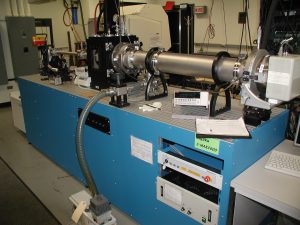
The ability to create nanostructures and their controlled assemblies on solid substrates and in bulk solutions is critical for advancement of many technologies. The Rigaku SMAX3000 aids in the study of nanostructures by using X-ray scattering for deducing nanoparticles’ shape, size distribution, assembly structure, and defects in a particular structure.
So what exactly is x-ray scattering?
X-ray scattering is the ideal non-destructive method for in-situ characterization of nanoscale structures and their formations. The Rigaku SMAX3000 is used for small- and wide- angle X-ray scattering measurements (SAXS and WAXS). The SAXS/WAXS measurements can be performed both in transmission and in reflection [grazing incidence (GI)-SAXS/WAXS] modes, using suitable sample stages. Therefore, the Rigaku SMAX3000 is suitable for samples in solution, powder, and thin film forms.
How small of nanostructures can the Rigaku SMAX3000 examine?
In the SAXS/GISAXS mode with Vantec 2D multiwire detector, the Rigaku SMAX3000 can be used to study nanostructures or their assemblies with characteristics dimensions in the range 60 – 1.5 nm. In, the WAXS/GIWAXS mode with phosphor screen detectors, the spatial range on the Rigaku SMAX3000 can be extended to study atomic scale structures down to 2 Å (Ångström: a unit of length equal to 10−10 m or 0.1 nanometer).
Who has used this instrument?
Selected examples illustrate the versatility of this in-house SAXS/WAXS system at Northwestern University:
- The Mirkin and Bedzyk groups utilized SAXS to study the assembly of DNA-coated gold nanoparticles in aqueous solutions. (Figures A and B)
- The Hersam and Bedzyk groups used the GISAXS capability to establish the orientational epitaxy between ZnO nanowires.
- The Stupp group utilized the GIWAXS capability with the image plate to study interlayer-spacing and orientation of organic-inorganic hybrid lamellar structures on solid substrates.
Who manages this equipment?
Jerry Carsello is the Facility Manager for the Jerome B. Cohen X-Ray Diffraction Facility, which is a part of the Soft and Hybrid Nanoscale Experimental (SHyNE) Resource. As Facility Manager, Jerry teaches laboratory courses, assists in X-ray experiments, maintains and makes improvements to facility equipment, assists new and current researchers in x-ray techniques, provides technical assistance for instruments, and offers analysis services for internal and external clients. Jerry has been with Northwestern University for 32 years, and enjoys spending his time outside of Northwestern with his family, volunteering, and reading.
His current book recommendation: ‘The Screwtape Letters’ by C.S. Lewis.
If you are interested in using the Rigaku SMAX3000, please contact Ben Myers at shyne@northwestern.edu or (847) 467-1081.


Your instrument showcases are so illuminating! Keep up the fascinating work.